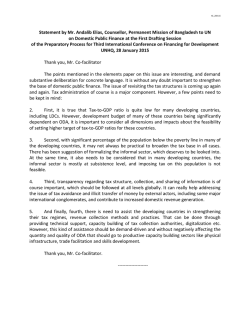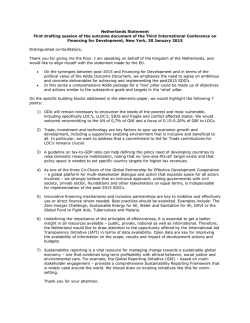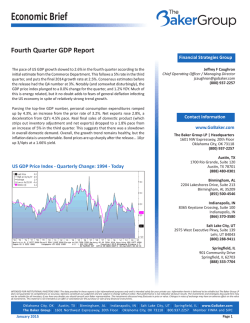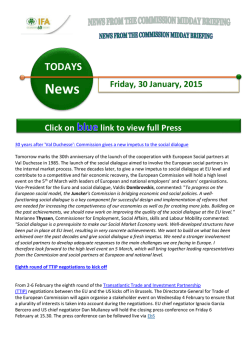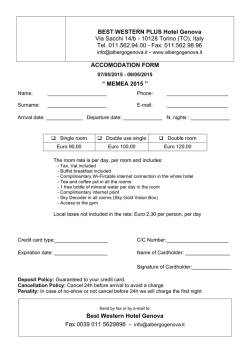
The tax-to-GDP ratio in 2015 continued to vary by 1 to 2
234/2016 - 25 November 2016 Taxation in the EU Member States The tax-to-GDP ratio in 2015 continued to vary by 1 to 2 across the EU Member States Taxes on production and imports main category in the EU The overall tax-to-GDP ratio, meaning the sum of taxes and net social contributions as a percentage of GDP, stood at 40.0% in the European Union (EU) in 2015, stable compared with 2014. In the euro area, tax revenue accounted in 2015 for 41.4% of GDP, slightly down from 41.5% in 2014. This is the first time since its low point in 2010 that the tax-to-GDP ratio in both zones did not increase. This information comes from an article issued by Eurostat, the statistical office of the European Union. Tax indicators are compiled in a harmonised framework based on the European System of Accounts (ESA 2010), enabling an accurate comparison of the tax systems and tax policies between EU Member States. Overall tax-to-GDP ratio in the EU and the euro area, 2005-2015 45 EU Euro area 40 35 2005 2006 2007 2008 2009 2010 2011 2012 2013 2014 2015 Highest tax-to-GDP ratio in France, Denmark and Belgium The tax-to-GDP ratio varies significantly between Member States, with the highest share of taxes and social contributions in percentage of GDP in 2015 being recorded in France (47.9%) Denmark (47.6%) as well as Belgium (47.5%), followed by Austria (44.4%), Sweden (44.2%), Finland (44.1%) and Italy (43.5%). At the opposite end of the scale, Ireland (24.4% - see country note), Romania (28.0%), Bulgaria (29.0%), Lithuania (29.4%) and Latvia (29.5%) registered the lowest ratios. Total revenue from taxes and social contributions in the EU Member States, 2015 (as % of GDP) 50 45 40 35 30 25 20 15 10 5 0 * See country note Largest growth of tax-to-GDP ratio in Lithuania and Estonia Compared with 2014, the tax-to-GDP ratio increased in 2015 in a majority of Member States, with the largest rises being observed in Lithuania (from 27.9% in 2014 to 29.4% in 2015) and Estonia (from 32.8% to 34.1%), ahead of Slovakia (from 31.3% to 32.4%), Hungary (from 38.3% to 39.2%) and Croatia (from 36.8% to 37.6%). In contrast, decreases were recorded in eight Member States, notably in Ireland (from 29.9% in 2014 to 24.4% in 2015 – see country note) and Denmark (from 50.3% to 47.6%). Change in tax-to-GDP ratio in the EU Member States, 2015/2014 (in percentage points) Ireland* Denmark Belgium Malta Luxembourg Cyprus Euro area Portugal Italy EU France Finland Slovenia Spain Latvia Netherlands Germany Poland United Kingdom Czech Republic Romania Austria Greece Bulgaria Sweden Croatia Hungary Slovakia Estonia Lithuania -6.0 * See country note -5.5 -5.0 -4.5 -4.0 -3.5 -3.0 -2.5 -2.0 -1.5 -1.0 -0.5 0.0 0.5 1.0 1.5 2.0 Highest ratio of taxes on production and imports in Sweden, of taxes on income and wealth in Denmark and of net social contributions in France Looking at the main tax categories, a clear diversity prevails across the EU Member States. In 2015, the share of taxes on production and imports was highest in Sweden (where they accounted for 22.1% of GDP), Croatia (19.7%) and Hungary (18.9%), while they were lowest in Ireland (8.9% – see country note), Germany and Slovakia (both 11.0%). For taxes related to income and wealth, the highest share by far was registered in Denmark (30.4% of GDP), ahead of Sweden (18.4%), Belgium (16.7%) and Finland (16.6%). In contrast, Bulgaria (5.4%), Lithuania (5.5%) and Croatia (6.0%) recorded the lowest taxes on income and wealth as a percentage of GDP. Net social contributions accounted for a significant proportion of GDP in France (18.9%), Belgium (16.7%) and Germany (16.5%), while the lowest shares were observed in Denmark (1.0% of GDP) and Sweden (3.7%). In 2015, taxes on production and imports made up the largest part of tax revenue in the EU (accounting for 13.6% of GDP), closely followed by net social contributions (13.2%) and taxes on income and wealth (13.0%). The ordering of tax categories was slightly different in the euro area. The largest part of tax revenue came from net social contributions (15.3%), ahead of taxes on production and imports (13.3%) and taxes on income and wealth (12.6%). Methods and definitions Data are collected by Eurostat on the basis of the European system of national and regional accounts (ESA 2010). According to ESA2010, taxes and social contributions should be recorded on an accrual basis. The data relate to the general government sector of the economy, as defined in ESA2010, comprising the subsectors central government, state government (where applicable), local government, and social security funds (where applicable). Data for taxes collected on behalf of the EU institutions is also included in the analysis. Thus revenue data for taxes and social contributions represent all tax and social contributions revenues collected at the EU level. The overall tax-to-GDP ratio presented in this news release corresponds to the total amount of taxes and net social contributions (including imputed contributions) payable to general government and the institutions of the European Union, including voluntary contributions, net of uncollectible amounts; expressed as a percentage of GDP. It is one measure of the tax burden. It encompasses the wide diversity of social security systems in the EU. Taxes are defined as compulsory, unrequited payments to governments or institutions of the European Union. Taxes on production and imports include value added tax (VAT), import duties, excise duties and consumption taxes, stamp taxes, payroll taxes, taxes on pollution, and others. Taxes on income, wealth, etc. include corporate and personal income taxes, taxes on holding gains, payments by households for licences to own or use cars, hunt or fish, current taxes on capital that are paid periodically, and others. Net social contributions are the actual or imputed contributions made by households to social insurance schemes to make provision for social benefits to be paid. They include employers' actual social contributions, households' actual social contributions, imputed social contributions and households' social contribution supplements. Social insurance scheme service charges are deducted from the items above to reach net social contributions. Actual social contributions are those paid on a compulsory or voluntary basis by employers or employees or the self- or non-employed to insure against social risks (sickness, invalidity, disability, old age, survivors, family and maternity). Imputed social contributions are those payable under unfunded social insurance schemes (in which employers pay social benefits to their employees, ex-employees or their dependents out of their own resources without creating special reserve for the purpose). Net social contributions also contain two transactions related to funded pension schemes, wherever such schemes are classified in general government. The tax-to-GDP ratio includes also capital taxes, which are generally of minor importance. Capital transfers representing amounts assessed but not collected are deducted from the total taxes and net social contributi ons to ensure the comparability of the tax-to-GDP ratios across countries. Country note: Ireland The Irish Gross Domestic Product for 2015, used as a denominator in tax-to-GDP ratios presented in this News Release, was substantially affected by the relocation from outside the EU to Ireland of balance sheets of large multi-national enterprises. More information can be found on the Eurostat website. For more information Eurostat Statistics Explained article on tax revenue statistics. Eurostat website section dedicated to government finance statistics. Eurostat database on government statistics. Issued by: Eurostat Press Office Production of data: Vincent BOURGEAIS Tel: +352-4301-33 444 [email protected] Raquel DIAS Pavel DVORAK Elvira GOEBEL Lukas RUCKA Laura WAHRIG Tel: +352-4301-37 687 [email protected] ec.europa.eu/eurostat @EU_Eurostat Media requests: Eurostat media support / Tel: +352-4301-33 408 / [email protected] Total revenue from taxes and social contributions in the EU Member States (as % of GDP) 2005 2010 2014 2015 EU 38.7 38.4 40.0 40.0 Euro area 39.5 39.2 41.5 41.4 Belgium 45.6 45.5 48.0 47.5 Bulgaria 30.5 26.0 28.4 29.0 Czech Republic 34.2 32.6 33.9 34.4 Denmark 49.4 46.3 50.3 47.6 Germany 38.5 38.2 39.7 40.0 Estonia 30.1 33.5 32.8 34.1 Ireland* 31.3 28.5 29.9 24.4 Greece 33.5 34.2 39.0 39.6 Spain 35.9 32.1 34.5 34.6 France 44.5 44.1 47.8 47.9 Croatia 36.2 36.1 36.8 37.6 Italy 39.2 41.7 43.5 43.5 Cyprus 31.4 31.9 33.2 33.0 Latvia 28.1 28.1 29.3 29.5 Lithuania 29.5 28.7 27.9 29.4 Luxembourg 39.2 38.6 39.4 39.1 Hungary 36.8 37.5 38.3 39.2 Malta 33.0 32.5 35.1 34.7 Netherlands 36.1 36.7 38.0 38.2 Austria 42.4 42.1 43.8 44.4 Poland 33.8 32.3 32.9 33.3 Portugal 34.2 33.7 37.1 37.0 Romania 28.3 26.9 27.5 28.0 Slovenia 38.2 37.4 37.0 37.1 Slovakia 31.4 28.2 31.3 32.4 Finland 42.3 40.9 44.0 44.1 Sweden 47.5 44.1 43.5 44.2 United Kingdom 34.6 35.2 34.4 34.9 Iceland 39.7 33.4 38.6 36.7 Norway 42.6 42.0 38.9 38.8 Switzerland 26.7 26.7 27.0 28.1 Serbia 38.9 38.5 37.4 37.3 * See country note. The source dataset can be found here. Structure of tax revenue in the EU Member States, by main tax category, 2015 (as % of GDP) Taxes on production and imports EU Euro area Belgium Bulgaria Czech Republic Denmark Germany Estonia Ireland** Greece Spain France Croatia Italy Cyprus Latvia Lithuania Luxembourg Hungary Malta Netherlands Austria Poland Portugal Romania Slovenia Slovakia Finland Sweden United Kingdom Iceland Norway Switzerland Serbia 13.6 13.3 13.2 15.5 12.5 16.4 11.0 14.6 8.9 16.2 12.0 16.0 19.7 15.3 14.9 13.0 12.0 12.2 18.9 13.7 11.7 14.6 13.0 14.6 13.4 15.0 11.0 14.3 22.1 13.0 15.1 12.0 6.1 19.4 Of which: VAT Taxes on income, wealth, etc. 7.0 6.8 6.7 9.0 7.3 9.4 7.0 9.2 4.7 7.3 6.5 6.9 13.0 6.2 8.6 7.7 7.7 6.8 9.7 7.8 6.6 7.7 7.0 8.6 8.1 8.3 6.9 9.1 9.1 6.9 8.3 8.2 3.5 10.2 * Including taxes on holding gains ** See country note The shares do not add up to the total due to rounding and other taxes not included in this table. 13.0 12.6 16.7 5.4 7.3 30.4 12.3 7.9 10.9 9.4 10.1 12.6 6.0 14.8 9.7 7.9 5.5 14.6 7.0 14.1 11.6 14.4 6.9 10.8 6.6 7.3 7.4 16.6 18.4 13.9 17.8 16.3 15.2 5.5 Of which: Taxes on individual or Taxes on the income or household income* profits of corporations* 9.4 2.5 9.3 2.5 12.6 3.4 3.1 2.1 3.6 3.4 26.5 2.6 9.1 2.4 5.8 2.1 7.7 2.7 5.4 2.2 7.4 2.4 8.8 2.6 3.6 1.9 12.2 2.0 2.7 5.9 5.9 1.6 3.9 1.5 9.2 4.5 5.0 1.7 6.8 6.7 7.7 2.7 10.9 2.3 4.7 1.8 7.3 3.1 3.7 2.3 5.1 1.5 3.1 3.7 13.3 2.2 15.1 3.0 9.2 2.5 13.8 2.4 10.7 4.9 9.2 2.9 3.6 1.7 The source dataset can be found here. Net social contributions 13.2 15.3 16.7 7.9 14.6 1.0 16.5 11.6 4.5 13.9 12.3 18.9 11.9 13.3 8.4 8.7 11.9 12.2 13.2 6.8 14.7 15.4 13.5 11.6 8.1 14.8 14.0 12.9 3.7 7.8 3.6 10.5 6.9 12.4
© Copyright 2026
